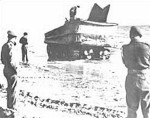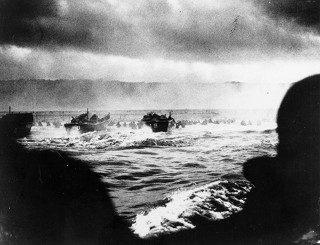|

|
60th
Anniversary of D-DAY
Normandy Invasion - Operation Overload: 2,500 Americans
fall at Omaha Beach, another 2,499 lost in airborne assault. During
the Normandy Campaign (6 June to 24 July), 16,293 Americans would
be Killed in Action and 41,051 Wounded in Action. On July 3, 1944
the "Battle of the Hedgerows"on the Contentin Peninsula
begins. On September 14, 1944 the Northern France Campaign would
end with an additional 17,844 Killed in Action and 47,469 Wounded
in Action.
|
|
“Tuesday, 6 June 1944, 03:30 hrs:
Reached transport area (Portland, England) and started down
mine swept channel to beach. Last ship in column of eight,
Ensign R. B. Gilfert, officer in charge, USS LCT-590.”
That morning my cousin Robert Gilfert from Erie (later Lake
Havasu City, AZ) was commanding a LCT ship with four DD
tanks and twenty men belonging to the 743rd Tank Battalion,
six vehicles and six men of the 81st Chemical Weapons Battalion
and four men attached to the 320th Barrage Balloon Battalion
towards Dog White Sector, Omaha Beach. In addition to the
standard twelve man crew on board ship.
Gilfert’s ship was one of twenty-four assigned the top secret
task of delivering these DD tanks to the invasion beach
at H-hour along with the infantry. These M4 Sherman tanks
were developed to swim undetected and were the brainchild
of British General Percy Hobart. The DD tanks were so called
because of their duplex drive which could activate either
their treads or twin propellers and a water proof, air filled
canvas shroud all around the hull gave them enough buoyancy
to swim into the beach at a speed of four knots. Then the
steel treads would be engaged, the canvas deflated and fully
operational Sherman tanks supporting and attacking with
the first assault waves of infantry.
The one problem that morning were the heavy seas and the
canvas shroud only had nine inches of clearance above the
sea level. Twenty-eight of the first thirty-two tanks launched
at 6,000 yards from shore were swamped and lost, taking
many lives with them. Orders were immediately dispatched
to the remaining LCTs to take the tanks directly to the
beach.
|
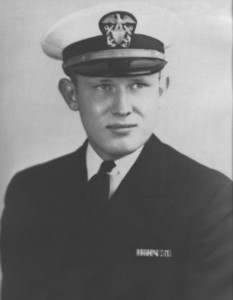
Lieutenant Junior Grade
Robert B. Gilfert
1921 - 1994
U. S. Navy Reserve |
|
|
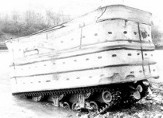 DD Tanks
DD Tanks |
|
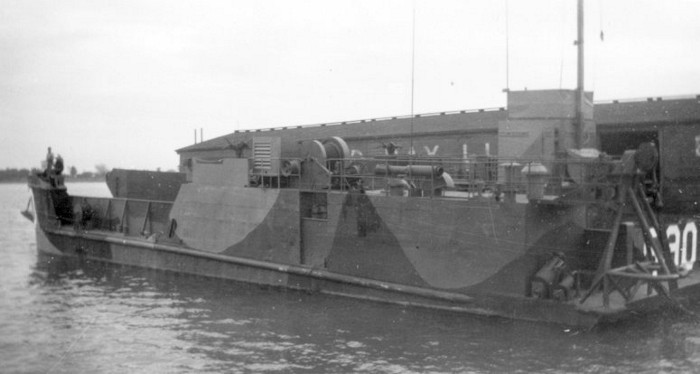
| “05:00 hrs, Received
message saying that tanks would have to be taken to the beach
due to weather conditions existing. 05:30 hrs, Maneuvered
090° left turn. 05:45 hrs, All ships make a 090° right turn
and headed for beach. 06:30 hrs, Hit beach with enemy shells
still falling around us. On the beach waiting for tanks to
go off. Were shelled by shore batteries and machine gun fire.
Return fire with our 20 mm guns and machine gun fire from
the tanks. 06:34 hrs, Last tank went off and we retracted
from beach.” |
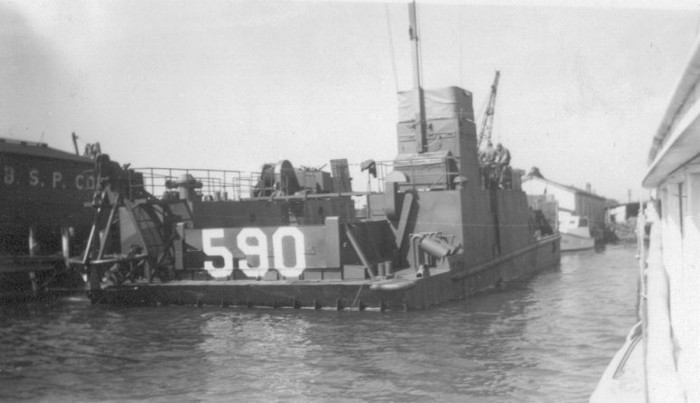
Gilfert’s LCT-590 was part of Flotilla
12, Task Group 124.4, Group O-2, Western sectors of Omaha
Beach - Easy Green, Dog Red, Dog White and Dog Green. A total
of twenty-four landing crafts delivering men and equipment
to support the 29th Infantry Division’s beach assault. Gilfert’s
LCT actually landed on the Dog Green Sector of Omaha Beach
facing the bluffs towards the village of Vierville.
LCT-590, 591, 713 and 588 landed sixteen Sherman tanks and
half were destroyed within minutes. The German fire was so
severe, LCT-590 would sustain serious casualties and damage
to the naval ship. German 88’s and machine gun fire pounded
the ship and killed Machinist Mate 2c C. Reed, Coxwain G.
Jackson and Electricians Mate 3c J. J. Gatins. Two additional
seamen were wounded as well as two Army personnel.
Five LCA’s landed men from Company A, 116th Infantry Regiment
and sustained eighty percent losses. LCT-2227 was damaged
by mines and beached. Two LCM’s landed personnel from the
Navy demolition teams and sustained seventy percent losses.
Another two LCA’s landed men from Company B,116th Regiment
and suffered seventy-five percent casualties and two LCVP’s
landed Company D, 116th Regiment, sustaining fifty percent
casualties. The previous night’s aerial bombardments and the
naval artillery immediately prior to the assault turned out
to be ineffectual.
The German defenses had remained practically untouched and
raked fire upon the attacking American forces. Very little
progress was made to push off the beach and this caused significant
backups on the beach. Slowly, as individuals and then in groups,
soldiers began to fight their way across the enemy fire-swept
beach. A few years ago, a film called Saving Private Ryan
depicted these actions on the beach in grave detail and showed
the horrors of combat experienced by soldiers and sailors
like my cousin that day.
The wounded from Gilfert’s LCT were evacuated to the USS Charles
Carroll (APA-28), an Attack Troop Transport ship. LCT-590
was so badly damaged that it began to take on water and was
in need of emergency repairs. LCT-536 substituted for the
590’s second assignment to land personnel from APA #3 on Dog
Red at H+180. The USS Arikara (ATF-98), a Navy Ocean Going
Tug was assigned to keep the beaches clear of wrecks, but
soon had to change jobs of rescue and repair ship. The German
mines, underwater obstacles and gun fire were taking a toll
on the small crafts. LCT-590 set sail for the USS Arikara
to receive emergency repairs. At 12:52, Arikara completed
repairs to LCT-590.
Ensign Gilfert was awarded the Navy Cross and Silver Star
for gallantry in action on D-Day. He was soon thereafter promoted
to the rank of Lieutenant Junior Grade. Electricians Mate
3c John J. Gatins, one of the crew killed in action, was buried
at Plot E, Row 5, Grave 21. Cambridge American Cemetery, Cambridge,
England. |
|

Ode to the LCT
Here’s to the men who sail the seas
On the bucking decks of the LCT’s.
The battleships, cruisers and destroyers as well
Get all the glory, the LCT’s catch hell.
And when its all over and the work is done
And the medals are given to the men who won,
And outfits are lauded by the powers that be
Forgotten as usual will be the LCT.
By Jim Howard
LCT(A)-2339 & LCT-244
|
|







